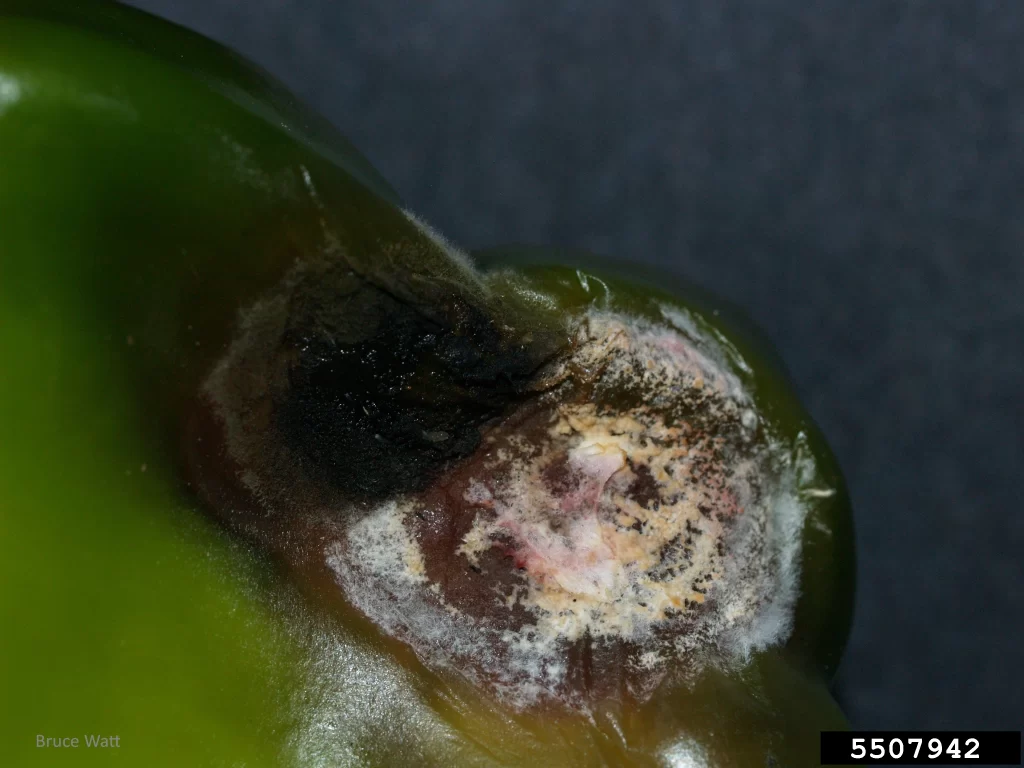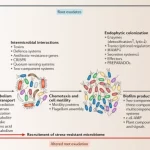Banner Image by Bruce Watt, University of Maine, Bugwood.org. https://www.invasive.org/browse/detail.cfm?imgnum=5507942&
Fusarium oxysporum f. sp. capsici
Introduction
Fusarium oxysporum f. sp. capsici is a soil-borne fungal pathogen that poses a significant threat to pepper crops. This pathogen is responsible for Fusarium wilt, a devastating disease that can lead to substantial yield losses. The economic impact of Fusarium wilt on pepper crops is substantial, with yield losses estimated at 68 to 71% in hot pepper species worldwide [1]. A study in an Ontario greenhouse in 2017 showed that Fusarium oxysporum led to 12-13% plant mortality at one greenhouse, causing a significant yield loss.
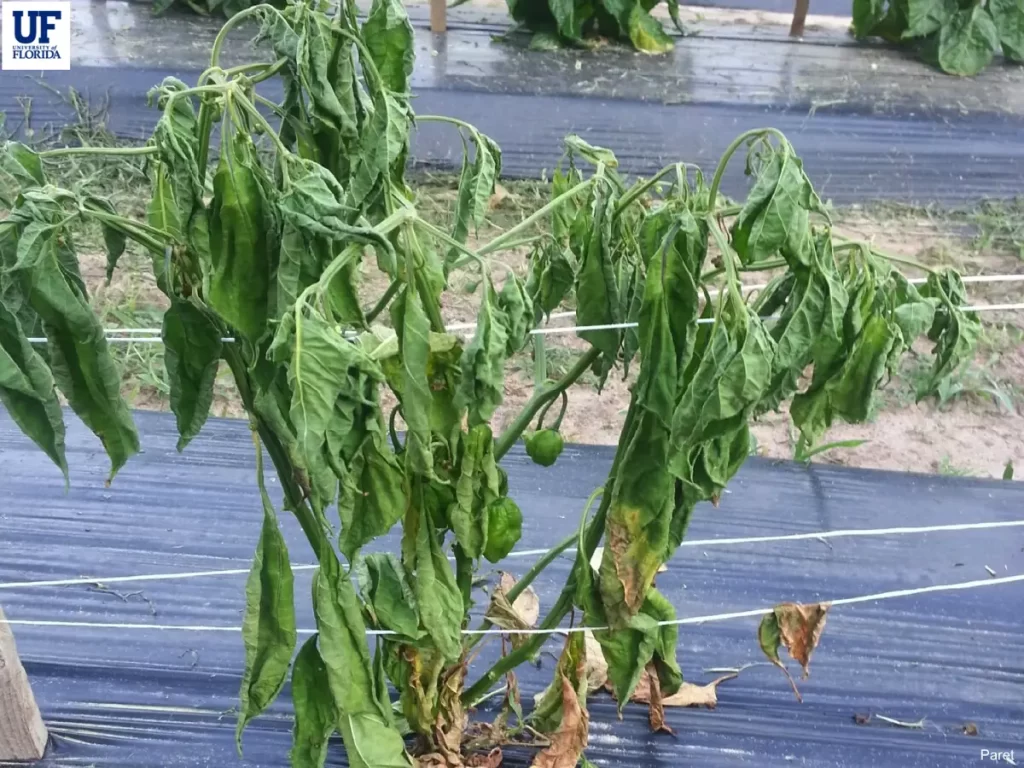
What makes Fusarium oxysporum f. sp. capsici different from other Fusarium oxysporum?
Fusarium oxysporum is a versatile species with a diverse range of hosts. Researchers use the specificity of its hosts to categorize it into various formae speciales (f. sp.). For example, Fusarium oxysporum with genes that have the ability to help it infect peppers are called Fusarium oxysporum f. sp. capsici [2]. Simply put, Fusarium oxysporum f. sp. capsici is still a Fusarium oxysporum that causes wilts and rots, but it now has genes to infect peppers better and peppers only.
We provide great overviews of many agricultural microorganisms. Subscribe to stay updated!
Symptoms
The symptoms of Fusarium wilt in peppers caused by Fusarium oxysporum f. sp. capsici are often severe and can lead to significant crop losses. The disease typically manifests as [2]–[4][ontario]:
- vascular wilt
- root rot
- foot and stem rot
- leaf lesions
- fruit rot
At the onset of the disease, the plant leaves may yellow and droop, usually on one side. As the condition advances, the whole plant may droop. Additional symptoms include browning of the xylem vessels, which can be noticed when the stems are slashed. [1], [3], [4].
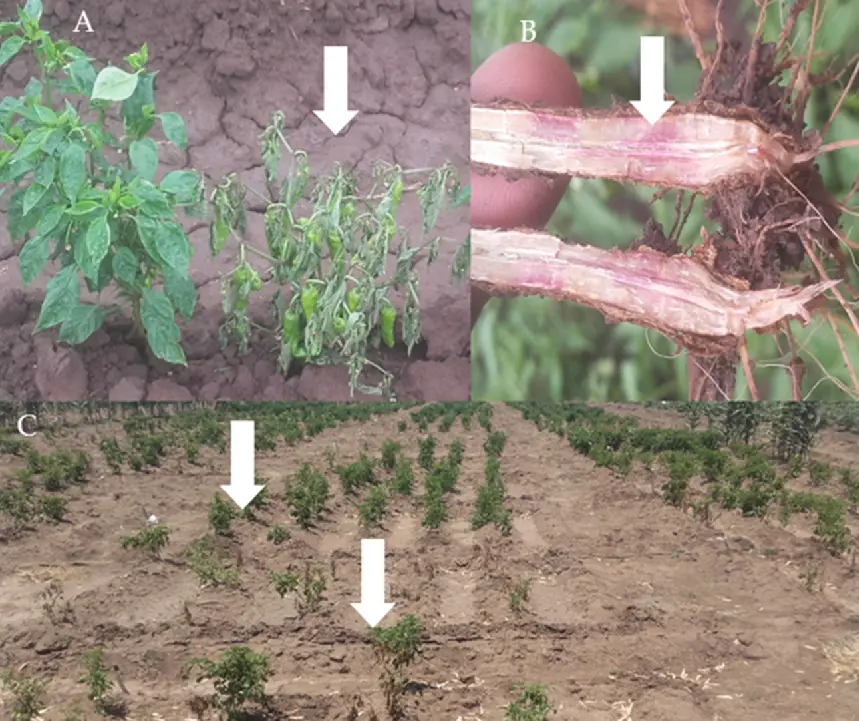
a) Entire plant wilt
b) Change in stem coloration
c) A section of peppers showing signs of Fusarium infection.
Image by Gabrekiristos (2020). https://www.semanticscholar.org/paper/Hot-Pepper-Fusarium-Wilt-%28Fusarium-oxysporum-f.-sp.-Gabrekiristos-Demiyo/c5d61d556911e49be31facaaa4fdda69cdabc748
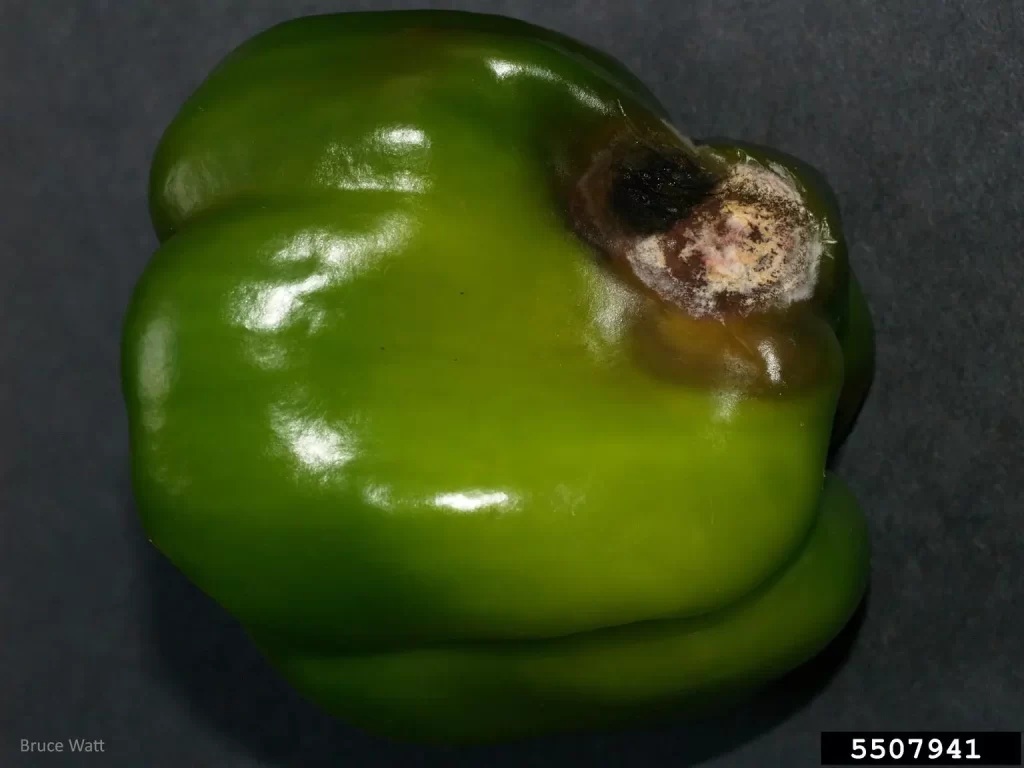
Life Cycle and Infection Stages
Fusarium oxysporum has a complex life cycle that includes sexual and asexual stages. The fungus primarily reproduces asexually, producing three types of spores: macroconidia, chlamydospores, and microconidia. These spores play a crucial role in the propagation and infection of the fungus [5]. The fungus enters plant tissues through wounds or by direct epidermis penetration [6]. Once inside the plant, the fungus invades the xylem vessels, disrupting the translocation of nutrients and leading to the characteristic wilting symptoms [6].
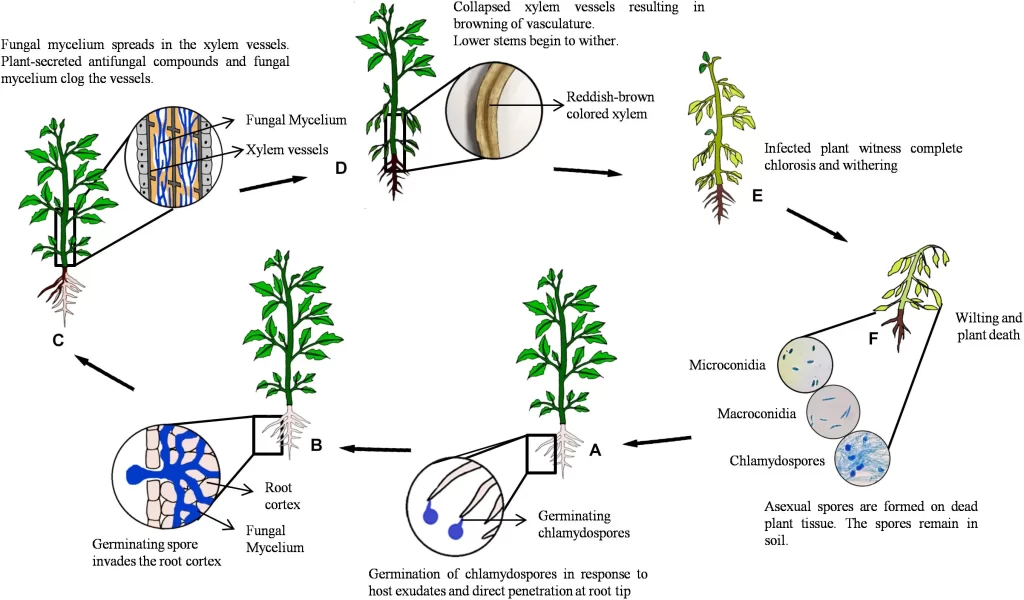
a) When the host plant releases root exudates, it stimulates the germination of spores, leading to the growth of infection hyphae, which then penetrate the root’s epidermal layer at its tip.
b) The hyphae move between cells in the root’s cortical region until they reach the xylem tissue, including the parenchymal cells and vessels, entering through xylem pits.
c) The pathogen then occupies the vascular vessels, resulting in blockages and brown discoloration due to the extensive growth of mycelia.
d) Early signs of infection become evident at the base of the stem and then gradually move upwards, causing the young leaves to wither.
e) In mature leaves, either a yellowing at the edges or a total loss of green colour (chlorosis) can be noticed.
f) As the disease advances, the host plant starts to wilt and eventually dies. On the deceased plant tissue, various fungal spores like microconidia, macroconidia, and chlamydospores are produced and subsequently spread throughout the soil.
Image from Jangir et al. (2021). https://www.frontiersin.org/articles/10.3389/fpls.2021.628611/full
Growth Conditions
The growth of Fusarium oxysporum f. sp. capsici is influenced by several environmental factors. The fungus exhibits optimal growth at temperatures between 23–27°C and a pH of 5 [6]. Additionally, a study observed that extra available nitrogen in the soil can lead to forming thick, dense, fluffy mycelium of Fusarium oxysporum [6].
Methods of Prevention and Control
Preventing and controlling Fusarium wilt in peppers involves a combination of cultural, physical, and chemical strategies. However, these strategies often have limited effectiveness due to the fungus’s ability to produce highly resistant chlamydospores and its widespread presence in the soil [5].
Next, Cultural control methods include removing or destroying crop residues and selecting resistant cultivars [3]. Physical control methods involve using heat and ultraviolet light to reduce the fungus spread in water [8]. Chemical control strategies include fungicides, although resistance to these chemicals is a growing concern [9].
Lastly, Biological control agents, such as Trichoderma species, have also been used to mitigate fungicide resistance and curb the spread of the disease. Additionally, the use of clean planting materials and irrigation water, as well as proper sanitation of farming equipment, can help prevent the spread of the pathogen [4], [8], [9].
Fusarium oxysporum and Ontario Greenhouse Peppers 2017
This study is the first to report on Fusarium oxysporum affecting soilless greenhouse pepper production in Canada [4]. Greenhouse pepper growers in Ontario faced a disease affecting their plants, which was not immediately recognizable as it was associated with other known conditions. Symptoms on plants were similar to those reported on nursery-grown sweet peppers in Spain, though there were some variations. The disease led to 12-13% plant mortality at one site, causing a significant yield loss. This disease was later identified as caused by one of the Fusarium oxysporum. The pathogen was determined based on cultural, morphological, and pathogenicity tests supplemented by PCR amplification. To manage and control the disease, the study mentions products like Mycostop® (Streptomyces griseoviridis) and Prestop® (Gliocladium catenulatum) as potential treatments.
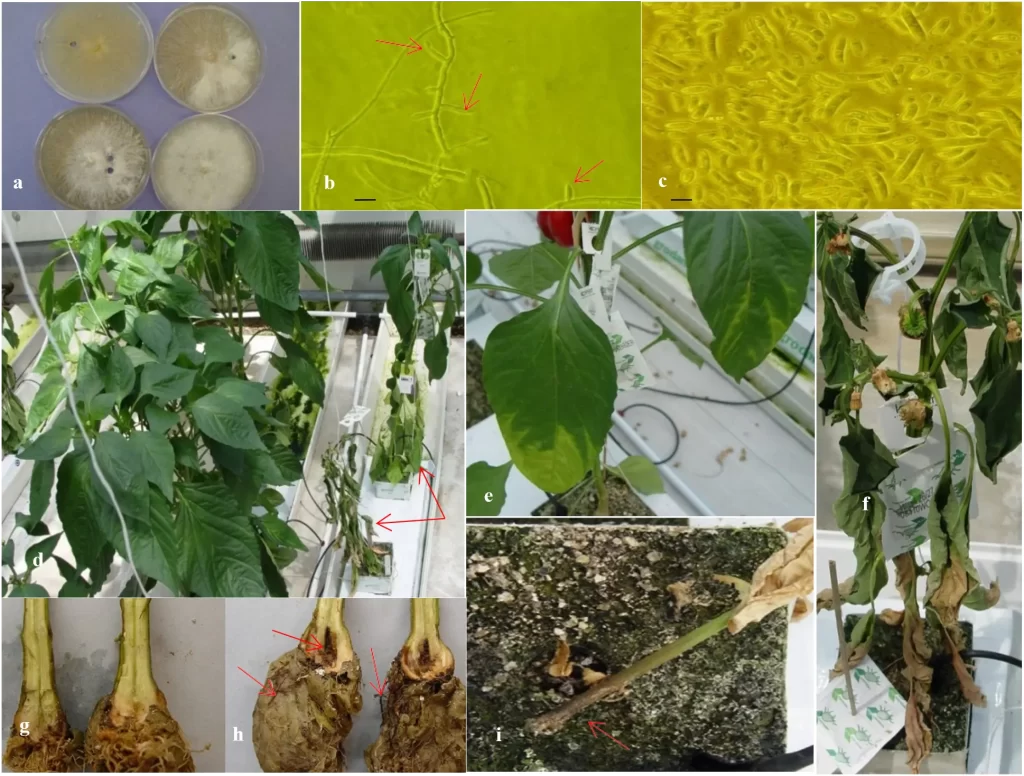
a) 14-day-old Fusarium oxysporum on aPDA plates.
b) Arrows pointing to the lateral subcylindrical monophialides with conidia
c) Picture of conidia (shows 1, 2, 3, and 4-celled conidia)
d) A side-by-side comparison of greenhouse ‘Fascinato’ pepper plants: a healthy, non-inoculated specimen (on the left) versus one displaying pronounced symptoms (on the right) marked by red arrows, captured 77 days post-inoculation. Note the evident stunting, wilting, and necrosis in the affected plant’s leaves.
e) A closer look reveals leaf chlorosis, starting from the leaf tip and extending to the vein tissue of the lower leaves.
f) As the disease progresses, there’s a noticeable onset of leaf necrosis, initiating from the plant’s lower leaves.
g) Crown tissue from control plants that received a water inoculation (no internal stem damage, healthy white roots and no crown damage.)
h) Crown tissue from plants post-inoculation with Fusarium oxysporum infections. The crown roots appear dark brown or even black (red arrows). The roots appear dark brown or black, with several instances of decay (red arrows). There’s also subtle discoloration within the stem. (i) A distinct dark brown discoloration is evident externally at the base of the ‘Fascinato’ pepper plant’s stem, as marked by the red arrow.
The paper emphasizes an integrated disease management strategy, suggesting a holistic approach rather than a single solution, from the importance of correctly identifying the pathogen to implementing corrective procedures. It is emphasized that correctly identifying Fusarium formae speciales requires inoculation onto many plant species and cultivars, indicating the need for comprehensive testing. Furthermore, treatment experiments were conducted, involving inoculation of plants and monitoring disease development over time. This method helped in understanding the disease progression and evaluating the effectiveness of potential treatments.
Conclusion
Fusarium oxysporum f. sp. capsici poses a significant threat to pepper crops by causing substantial economic losses due to reduced yields. Although several methods exist for prevention and control, their effectiveness is often limited because of the misidentification, the fungus’s resistance mechanisms, and its prevalence in the soil. Therefore, continuous research and development of new strategies, utilizing biological control agents, and the discovery of better fungicides are crucial for managing this pathogen and ensuring the sustainability of pepper production.
Disclaimer
The information we present in Pathogen Profile is based on collating published peer-reviewed scientific literature, and sources we think are reliable. This is by no means an exhaustive review of pathogens. Pathogen Profile gives a small glimpse of what is known about pathogens. We encourage growers to do more research on the pathogens concerning their crops and hydroponic systems. We are not plant pathologists; thus, the information presented in the Pathogen Profile should not be used as professional advice to treat pathogens or operate your system.
References
[1] E. Kabeto and T. Demiyo, “Hot Pepper Fusarium Wilt (Fusarium oxysporum f. sp. capsici): Epidemics, Characteristic Features and Management Options,” Thai J. Agric. Sci., vol. 12, Sep. 2020, doi: 10.5539/jas.v12n10p347.
[2] L.-J. Ma et al., “Fusarium Pathogenomics,” Annu. Rev. Microbiol., vol. 67, no. 1, pp. 399–416, Sep. 2013, doi: 10.1146/annurev-micro-092412-155650.
[3] OMAFRA, “Fusarium stem and fruit rot of greenhouse pepper,” 2022. https://www.ontario.ca/page/fusarium-stem-and-fruit-rot-greenhouse-pepper
[4] R. F. Cerkauskas, “Etiology and management of Fusarium crown and root rot (Fusarium oxysporum) on greenhouse pepper in Ontario, Canada,” Can. J. Plant Pathol., vol. 39, no. 2, pp. 121–132, Apr. 2017, doi: 10.1080/07060661.2017.1321044.
[5] M. Ajmal, A. Hussain, A. Ali, H. Chen, and H. Lin, “Strategies for Controlling the Sporulation in Fusarium spp.,” J. fungi (Basel, Switzerland), vol. 9, no. 1, Dec. 2022, doi: 10.3390/jof9010010.
[6] K. Chakrapani et al., “Deciphering growth abilities of fusarium oxysporum f. sp. pisi under variable temperature, pH and nitrogen.,” Front. Microbiol., vol. 14, p. 1228442, 2023, doi: 10.3389/fmicb.2023.1228442.
[7] P. Jangir, N. Mehra, K. Sharma, N. Singh, M. Rani, and R. Kapoor, “Secreted in Xylem Genes: Drivers of Host Adaptation in Fusarium oxysporum ,” Frontiers in Plant Science , vol. 12. 2021. [Online]. Available: https://www.frontiersin.org/articles/10.3389/fpls.2021.628611
[8] S. Ullah, D. Mostert, K. Serfontein, and A. Viljoen, “The Survival and Treatment of Fusarium oxysporum f. sp. cubense in Water.,” J. fungi (Basel, Switzerland), vol. 7, no. 10, Sep. 2021, doi: 10.3390/jof7100796.
[9] S. Iftikhar, L. Bengyella, A. A. Shahid, K. Nawaz, W. Anwar, and A. A. Khan, “Discovery of succinate dehydrogenase candidate fungicides via lead optimization for effective resistance management of Fusarium oxysporum f. sp. capsici,” 3 Biotech, vol. 12, no. 4, p. 102, 2022, doi: 10.1007/s13205-022-03157-8.
![]()
David Santos is the COO/CMO of Healthy Hydroponics InnoTech


